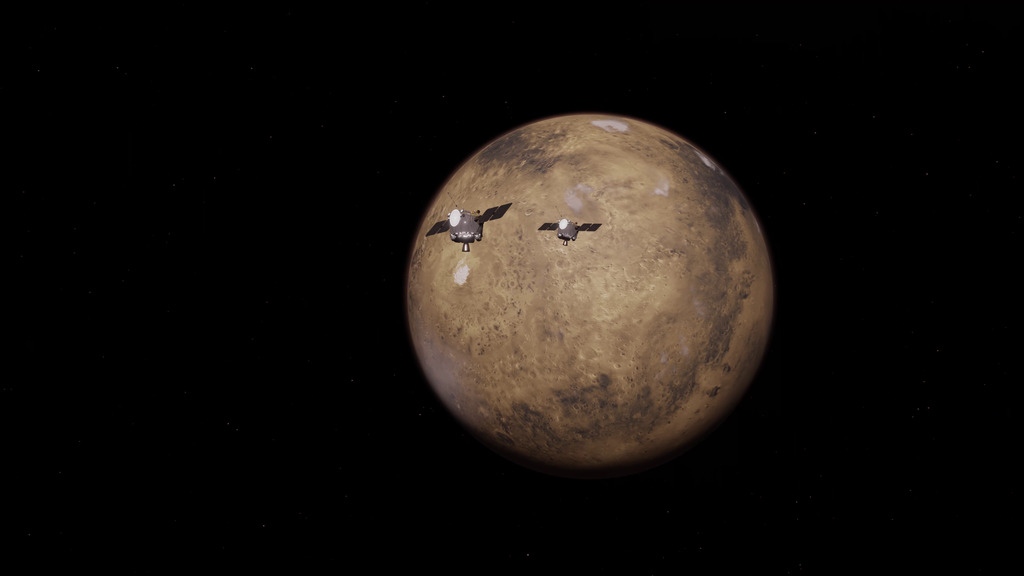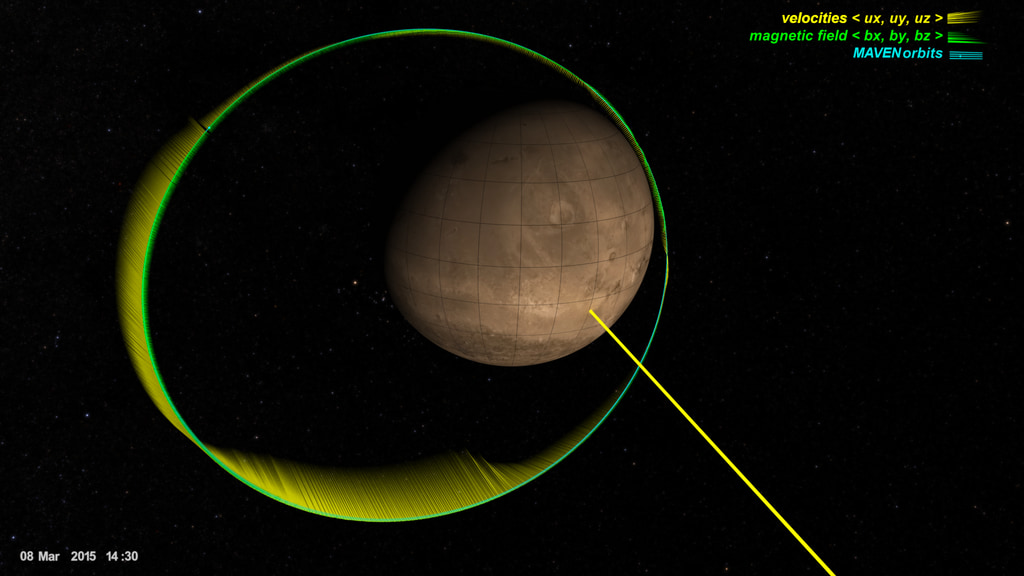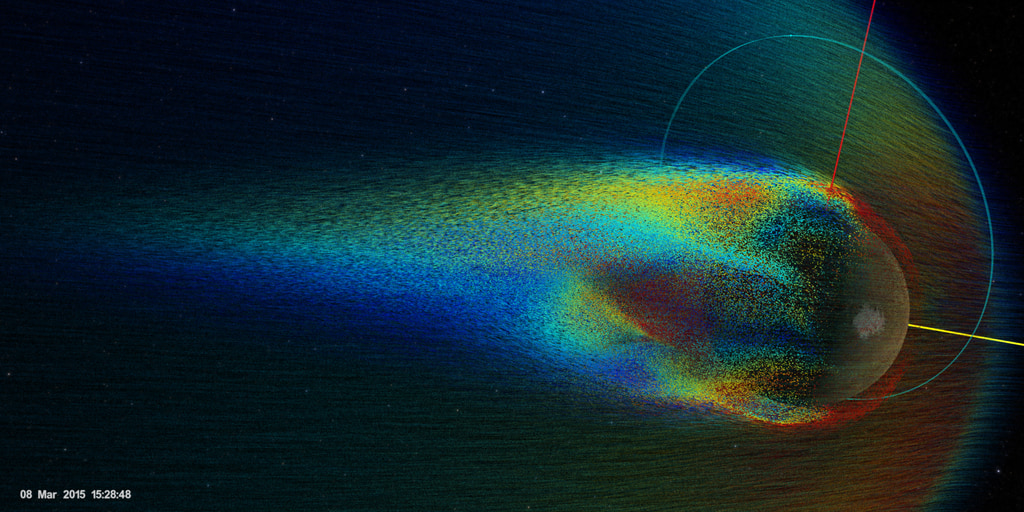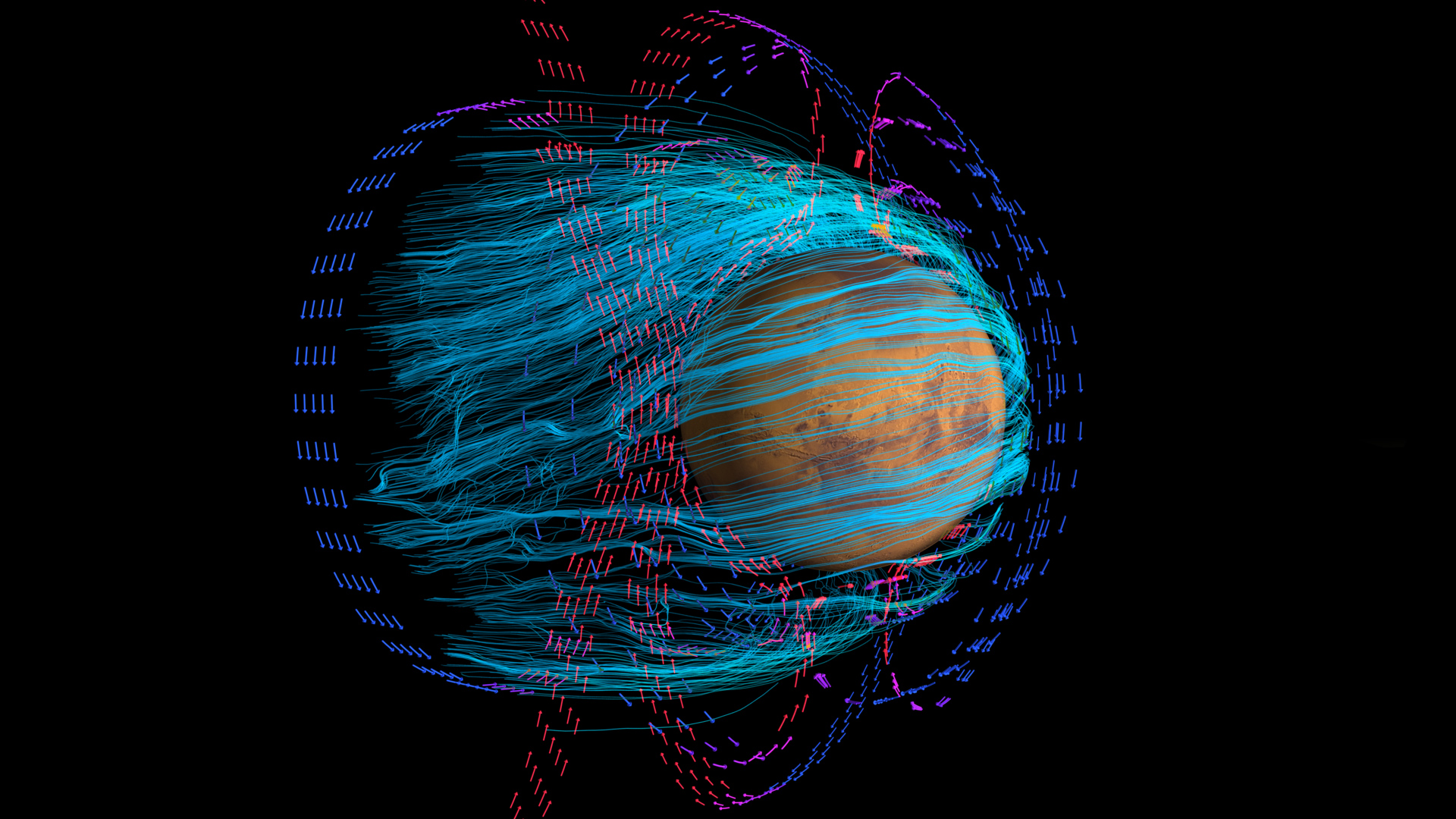MAVEN – Mars Electric Current Systems
The current systems formed around Mars as a result of a solar wind driven convective electric field
(Note: These frame sets were converted to the sRGB color space on 6/16/2020)
Unlike the Earth, Mars lacks a global magnetic dipole. Because its upper atmosphere is ionized by solar X-rays and extreme ultraviolet (EUV) radiations, the ionosphere of Mars presents a highly conductive obstacle to the flow of the magnetized solar wind plasma. The resulting interaction induces electric currents in the ionosphere which, in turn, create sufficient magnetic pressure to slow and deflect the solar wind around the bulk of the ionosphere, forming an induced magnetosphere.
NASA scientists used magnetic field measurements from the Mars Atmosphere and Volatiles EvolutioN (MAVEN) orbiter to make the first quantitative global map of the induced currents that shape the Martian induced magnetosphere. In doing so they found strong asymmetries between the north-south electric-polar hemispheres, particularly in the concentration of sunward currents, an electric connection between the planet's ionosphere and its bow shock, as well as a twist in the global near-Mars current system. Mapping the currents reveals how the solar wind's energy transfers into the induced magnetosphere where it powers escape of the Martian atmosphere.
Here we show visualizations of the actual and the idealized current systems that are formed as a result of a solar wind driven convective electric field. In addition, a sequence of calculated magnetic fields measured by MAVEN shown here illustrates that magnetic fields are forced to wrap around the planet by currents induced in Mars’ ionosphere.
An average magnetic field around Mars has been calculated from MAVEN measurements. The sequence of these magnetic fields shown here illustrates that magnetic fields are forced to wrap around the plant by currents induced in Mars’ ionosphere. The calculated MAVEN magnetic field is not time-varying, but this sequence illustrates how solar wind magnetic fields are changed as they move past Mars. The direction of the solar wind emanating from the sun is represented by a yellow arrow.
(Note: This frame set was converted to the sRGB color space on 6/16/2020)
This animation shows the same sequence of magnetic fields as the previous animation, but all the fields (except one) are shown as semi-transparent to emphasize the fact that they all represent a single magnetic field configuration.
(Note: This frame set was converted to the sRGB color space on 6/16/2020)

An image of the sun-facing view of the Mars current system with transparency

An image of a side-facing view of the Mars current system with transparency

An image of a side-facing view of the Mars current system with the bow shock and IMB with transparency

An image of the Mars current system from the dark side with transparency

An image of the Mars current system from the dark side with the bow shock and IMB with transparency
The bow shock (BS) and induce magnetosphere boundary (IMB) of Mars
(Note: These frame sets were converted to the sRGB color space on 6/16/2020)
The actual detailed electric currents measured by the MAVEN orbiter
(Note: These frame sets were converted to the sRGB color space on 6/16/2020)
Credits
Please give credit for this item to:
NASA's Scientific Visualization Studio
-
Visualizer
-
Cindy Starr
(Global Science and Technology, Inc.)
-
Cindy Starr
(Global Science and Technology, Inc.)
-
Data visualizers
- Horace Mitchell (NASA/GSFC)
- Tom Bridgman (Global Science and Technology, Inc.)
-
Scientists
- David Brain (University of Colorado Boulder)
- Robin Ramstad (University of Colorado Boulder)
- Yaxue Dong (LASP)
- Jared Espley (NASA/GSFC)
- Bruce Jakosky (LASP)
- Jasper Halekas (University of Iowa)
-
Producer
- Dan Gallagher (USRA)
-
Project support
- Leann Johnson (Global Science and Technology, Inc.)
- Eric Sokolowsky (Global Science and Technology, Inc.)
-
Technical support
- Laurence Schuler (ADNET Systems, Inc.)
- Ian Jones (ADNET Systems, Inc.)
Related papers
https://www.nature.com/articles/s41550-020-1099-y
https://www.nature.com/articles/s41550-020-1099-y
Datasets used
-
Magnetic Field Vectors [MAVEN: MAG]
ID: 1082 -
Ion Fluxes [MAVEN: SWIA]
ID: 1083
Note: While we identify the data sets used on this page, we do not store any further details, nor the data sets themselves on our site.
Release date
This page was originally published on Monday, May 25, 2020.
This page was last updated on Monday, January 6, 2025 at 12:14 AM EST.





